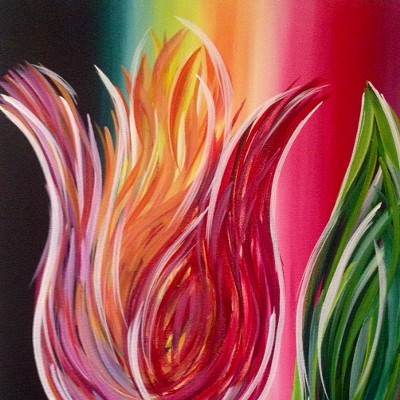"Physiology is not easy, especially when you're trying to paint," explains Given. "I'd like to try art; I'm still young."
On Sept. 18, Given's first-ever exhibit, Paint By Number, will debut at 7 Black Cats (260 E. Congress St.). Rock bands The Retainers, The Strays and Chango Malo will jam along with six of Given's very "loud" paintings: "Lean," "Georgia," "David," "Cubical," "The Model" and "Hey!"
Given's loudest painting, "Hey!" is a 5-foot rendering of his brother, Travis Given--a stylish, humorously daunting figure rocking before a hot pink background. Inspired by a test photo Travis took for a modeling agency in Phoenix, "Hey!" is dearly loved by its creator for being "humongous, pink and bold." The blues, purples and pinks lend it a unity and magnetic force. The figure of Travis nonchalantly swings his hands--hands that were executed with infinite detail; the bones, veins and wrinkles bestow a certain realism upon this seemingly pop-art portrait.
"Physiology helps (my painting)," Austin Given says. "I know where muscles are. ... When I paint something, I know what the muscle does. And when there's movement, I know what muscles are in action ... what bones there are (and) where veins are."
British pop artist Richard Hamilton dubbed pop art "young, witty, sexy, gimmicky (and) glamorous." While Given's work certainly has these pop-art qualities, his paintings are charged with an unusual depth of attitude and emotion. Each work is a fluid, dynamic moment captured in all its detail and then distorted.
Given's Web site, www.austingiven.com, describes Given's creative process as "a combination of photo projection and painting. Photographic images are collected and projected onto a canvas. First the basic shapes and shadows are applied in oil or acrylic paint to make the subject as realistic as Mr. Given chooses. Then the image is taken through many steps of alterations where Mr. Given pushes himself to create something he never has." In addition, Given may use his computer to "adjust" his photographic template.
In combining the photo, the computer and the canvas, Given's work displays that pop-art tendency of being machine-produced. Unlike pop art, however, Given's work is not a deliberate mockery of artistic technique and convention. While Given does believe "when you become trained too much, you become an art student--your work loses its soul," his view is not so much a devaluation of artistic convention as it is a warning against becoming stifled by antistatic convention.
Indeed, Given is a self-taught artist who strives to imbue his work with originality and intrigue. Through its compelling use of distortion, Given's painting "Marilyn" is a work both gruesome in its deformity and beautiful in its sensuality. Given reflects and distorts an image of pop culture who is himself a reflection and distortion of pop culture (Marilyn Manson's name is derived from the names Marilyn Monroe and Charles Manson). Through this triple layer of pop symbolism, "Marilyn" has the capacity to evoke a startling, emotional response in participants of pop culture. By naming the painting "Marilyn" (and not "Marilyn Manson"), Given leaves the question of identity open. Much like Marilyn Manson himself, the viewer fuses cultural icons and transposes a cultural meaning and identity (the perverse horror of Charles Manson and the tragic sensuality of Marilyn Monroe) onto the canvas.
While Given's "Lean" bears a resemblance to Edvard Munch's recently stolen "The Scream," its modern-day style and coolness serves to mock its 19th-century counterpart. Instead of clasping its head, Given's figure reclines against a rail, right index finger poised in a "tsk, tsk" motion. While Munch's sexless figure is swallowed up in the quicksand chaos of its surroundings, Given's confident male youth dominates and commands his surroundings. It's as if Given is reprimanding the intense pathos and anxiety of earlier artists.
"There are not a lot of painters that speak to me," says Given. Like "Marilyn," the likeliness "Lean" bears to a famous image gives the painting residual meaning.
But Given divorces himself from much of this "meaning." Beauty, style and novelty are his chief goals. He does not intentionally inject his works with meaning and symbolism.
"Art is eye candy," says Given, who goes on to explain that viewers will always coat what they see with meaning. Given's true artistic inspiration or motivation comes from the exhilarating nature of the artistic process. "(Painting) is the most fun thing I could think of doing," he says. "I think the most scared I've ever been was doing a painting ... like whether I'd mess up or not. ... My hands shake. It's relaxing/not (relaxing). ... Usually, I have music playing (while I paint) and just jump around. You probably don't want to see me painting."
Though Given denies infusing meaning into his work, he admits his desire to produce "interesting" pieces. Given's statement on his Web site reads, "Anyone can go through the motions and create the likeness of any object, while not pushing the boundaries of what can be done with the interpretation of that object. I strongly believe it is the artist's duty to push all boundaries to create something not only original, but beautiful."










